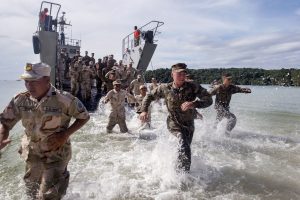Military bases are a touchy subject in Cambodia – never more so than in recent years given Phnom Penh’s cozy relationship with Beijing, which has alienated regional powers and the United States with its string of pearls strategy and expansive maritime claims in the South China Sea.
Three weeks ago Washington upped the ante by sanctioning a Chinese company and a Cambodian general over their mistreatment of villagers at Dara Sakor on the country’s southwest coast, where a massive property development has been labelled a potential military base by many Western defense analysts.
This week, the focus shifted to the nearby Ream Naval Base, where a U.S.-built building has reportedly been demolished and slated for redevelopment as part of the government’s “Master Plan” for a maritime center based around nearby Sihanoukville.
The details were contained in a report released by the Asia Maritime Transparency Initiative at the Washington-based Center for Strategic and International Studies. Satellite images showed that one of many buildings had been removed.
A slew of claims and counterclaims followed, amid ongoing speculation that China had signed a secret agreement giving it access to Ream Naval Base, through a deal struck with Defense Minister Tea Banh.
“We are disappointed that Cambodian military authorities have chosen to demolish a maritime security facility that is only seven years old and was a sign of U.S.-Cambodia relations,” said Chad Roedemeier, Information Officer at the U.S. Embassy in Cambodia in Phnom Penh.
“Such a military presence would negatively impact the U.S.-Cambodia bilateral relationship and be disruptive and destabilizing to the Indo-Pacific region.”
The Cambodian government has repeatedly denied reports of a secret agreement granting China access to the Ream Naval Base. This week, the government released a translated excerpt of a speech given by Prime Minister Hun Sen in June, in which he reaffirmed the denials, saying that “everything in Cambodia must be reported to the Prime Minister” and asking, “Why is it such a fad to paint Cambodia black?”
In his speech, Hun Sen said that Cambodia needed it’s own dockyards as rusty fishing boats were sent to Thailand for fixing, while combat vessels were sent to Vietnam and sometimes Malaysia for repairs.
Of course the Cambodians can do anything like with their ports. It is their country and foreign military bases, as Hun Sen noted, are not permitted under the country’s constitution. Instead, the Cambodian leader said new port facilities would be funded by China, but that funding from other countries was also welcome.
Importantly, Hun Sen said the dockyards would also be open to all, adding: “If one foreign navy ship can make a port visit here then ships from other countries can do the same.”
“We can allow access to ships from many countries to dock cargo ports, but Ream Naval Base is a military port, so you need to ask for permission. We welcome ships from any country not exclusively just Chinese ships to dock, refuel, or hold joint military exercises with Cambodia.”
This is not dissimilar to policies initiated by the Vietnamese government, which upset China a decade ago when announcing the world’s naval fleets would have access to its deep water port at Cam Ranh Bay.
Back then, the idea that battleships from India, Japan, Australia, and the U.S. could set sail through disputed waters within striking distance of the Chinese coast and find a safe harbor in nearby Vietnam was as controversial as the military posturing in Cambodia is today.
Since 2010, the Ream Naval Base has received funding and support from the U.S. and Australia and has been used for joint U.S.-Cambodian naval training and exercises with other countries, like Japan, chipping in for maintenance the government here says it can ill-afford.
Cambodia’s 443-kilometer coastline is tiny when compared with its neighbors, Thailand and Vietnam, but it sits smack in the middle of trade routes coveted by China and Phnom Penh’s swing into Beijing’s political orbit has made its claims of neutrality difficult to swallow in Washington.
It’s also easy fodder for Sam Rainsy, the interim leader of the banned opposition Cambodia National Rescue Party, who said military commitments to China violated Cambodia’s policy of strict neutrality and commitments made under the 1991 Paris Peace Agreements.
That’s a big call – but China’s investment strategy along the Cambodian coast will continue to raise more than eyebrows and the critics will never be far away.
Luke Hunt can be followed on Twitter @lukeanthonyhunt

































